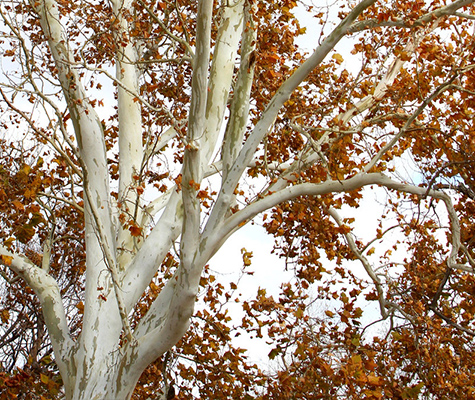American Sycamore
Platanus occidentalis

Overview
The American Sycamore tree is able to grow up to 100 feet tall with a width of 40 to 70 feet, making it one of the largest hardwood tree in North America. It grows at a rate of 2 feet per year. Flowers grow on the tree in April and May and produce fruit balls. The tree's bark has outer layers that will peel and expose lighter inner layers. It is known for its vibrant, bright golden yellow color in the Fall. The Sycamore foliage is created from its twigs, large leaves, bark and fruit balls.
Cultivation
The American Sycamore is tolerant of clay, sand, loam, alkaline and wet soils. However, it prefers full sun with moist, fertile soils. Having a moderate drought tolerance, it actually reaches its largest size along streams, rivers and flood plains. It grows in late Spring when the drier weather prevents fungal growth.
Biodiversity Sustained
Birds and other small animals eat the seeds that the Sycamore tree produces. Older Sycamores can develop cavities for owls, flycatchers, and chimney swifts. The tree also carries potential insect problems including borers, scales, Japanese beetles, caterpillars and spider mites. It is extremely prone to annual infections of anthracnose, a fungus that can be counteracted if grown in late Spring.
On Xavier's Campus, over the Next Decade, this Tree will:
Stormwater Runoff Intercepted: 31,160-78,290 Gallons
CO2 Reduction: 4,610-7,130 lbs
Electricity Savings: 820-1,710 kilowatt/hours
Environmental Benefits (in US dollars): $520-$770